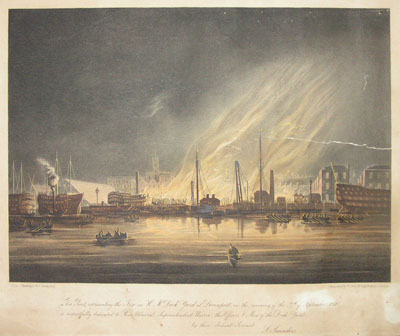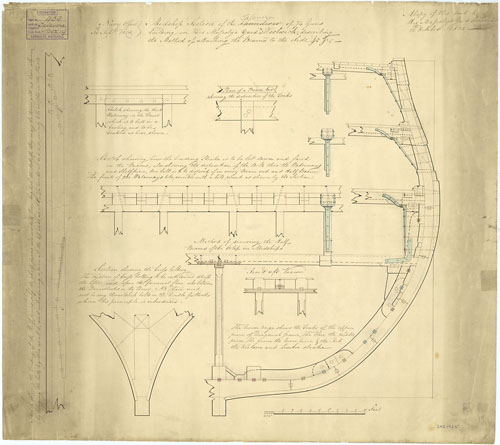HMS Imogene, HMS Talavera
The Talavera was 74 gun 3rd rate, built at the Woolwich dockyard. A Repulse class ship, she was built to Rule's design and timbered using Sepping's principle which used smaller timbers than usual. When orginally ordered on the 28th February 1814 she was to be called Thunderer, but this was changed to Talavera in 1817, prior to her launch on the 15th October 1818.
An awful but grand conflagration, attended with the entire destruction
of a line-of-battle-ship, and frigate and an immense amount of
public property, occurred in this dockyard on Sunday morning
Devonport Telegraph, 27th September 1840
In Devonport Dockyard around 4:20 a.m., on Sunday 27th September 1840, Police Officers Codd and Quick were on duty. The yard workmen had left on Saturday evening as usual and everything seemed to be in order. The policemen were near the three northern docks that contained the Talavera, Minden (74) and the sixth rate Imogene, when they noticed smoke coming from the bow port holes of the Talavera.
The officers ran to the gate station and within a few minutes of the alarm being raised Superintendent Lt. Williams and his men were quickly on the scene. The engines were brought out and the alarm bells rung with members of the 11th, 53rd, 65th, Royal Marines and Artillery all coming to assist in the yard. By this time fire had 'burst forth with tremendous fury' and had caught the roof over the dock. Although in the first instance it was ordered that no-one was to be admitted to the dockyard, the gates were soon opened, and the multitude that had gathered all put their effort into containing the blaze.
At a quarter to five the Talavera was fully aflame, the moderate westerly wind threatened to take the fire to the edges of the yard. As the Minden lay at the stern of the Talavera she quickly took fire and at one point appeared lost. However a fortuitous shift in the wind and the efforts of the ordinary engines, led by Commander Richards, halted the progress of the flames. Whereas the wind aided the Minden, an adjoining shed, bore the misfortune as it caught fire. Beneath the shed was the Adelaide Gallery, containing a collection of ships figureheads and nearly 300 workmens's tool chests, which were then all lost before 5 o'clock. The flag that Nelson flew at the Battle of Trafalgar was also suspended at one end of the hall so that too was gone.
A quarter past five and the fire had spread to the roof of the south dock, beneath which was the Imogene.
By six the Imogene was completely consumed by the fire. The instensity of the heat meant that no-one could approach in order to dowse the flames, or to hose the piles of timbers surrounding her; which were now burning freely. As soon as they could all attention was turned to the 'fiery mass' and the engines were focused on containing the blaze before it could spread to the rigging house and store houses, who's paint and windows had begun to melt. At one point at least 80 engines toiled in an attempt to stop the fire; the blaze of timbers was contained but not before the Talavera had burned to the waterline.
"both the ship and the roof were one mass of flame, presenting a most extraordinary appearance, especially from the river"
The Talavera and Imogene were total losses. Although at auction their value would have only been £20,000 and £10,000 respectively, to replace the Talavera however would have cost in the region of £70-80,000. The Minden, though damaged; most heavily on the main deck and forecastle, was repairable. The second time she had escaped fire in the same dockyard, the previous being in 1823. The granite facings of the dock were split to pieces, however the fire was stopped before it was able to damage where property amounting to the value of £5,000,000 was stored.
There can be little doubt, but this fire was the work of an incendiary:
but whether Papist, Chartist, Russian or Frenchman, cannot be ascertained
The Hull Packet, 2nd October, 1840
That the fire occured in the first place was something of a mystery. Upon leaving the Talavera, at around six p.m on the Saturday, Mr Spiers; the ship's warrant officer, noted that 'there was not a chip or a shaving anywhere to be seen about the vessel, nor had any candle been burnt or fire lighted on board'. Also a patrol was made only a forty-five minutes before the discovery of the fire, with a police Inspector Carlyon commenting that was nothing of 'unusual appearance'. The sentinel on duty was located about 30 yards from the bow of the Talavera, yet was unaware of the fire until the alarm had been raised.
The town then added to the rumours that the fire was set on purpose. A local boy, named Gilbert Green claimed that he overheard some men in Torpoint planning the destruction. Whereas elsewhere it was assumed to a be Chartist plot. The following week an attempt was made to set fire to the Sheerness docks, which though discovered in time, further cast doubt on the fire at Devonport. Although there were rumours of mysterious foreigners sighted around the docks on the night in question, the reality of the fire appeared to be accidental in nature, according to a Times reporter. The Talavera had been impregnated with coal tar in attempt to prevent dry rot, with the downside of making the vessel extremely flammable. Added to this was the proximity of a nearby waste pile in the Talavera's shed. The waste included, oakum, tallow and waste paint among other things, it was assumed that this mass could have spontaneously combusted and then easily communicated the flames to the Talavera. This was later stated as a reason after it was realised that the ship did not burn from the hold upwards, rather from the shed downwards.
![]() If you have any more information about this ship then please contact us.
If you have any more information about this ship then please contact us.





